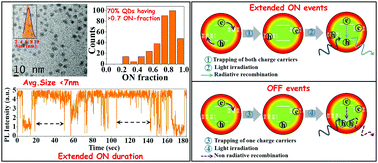Nearly suppressed photoluminescence blinking of small-sized, blue–green–orange–red emitting single CdSe-based core/gradient alloy shell/shell quantum dots: correlation between truncation time and photoluminescence quantum yield†
Abstract
CdSe-based core/gradient alloy shell/shell semiconductor quantum dots (CGASS QDs) have been shown to be optically quite superior compared to core–shell QDs. However, very little is known about CGASS QDs at the single particle level. Photoluminescence blinking dynamics of four differently emitting (blue (λem = 510), green (λem = 532), orange (λem = 591), and red (λem = 619)) single CGASS QDs having average sizes <∼7 nm have been probed in our home-built total internal reflection fluorescence (TIRF) microscope. All four samples possess an average ON-fraction of 0.70–0.85, which hints towards nearly suppressed PL blinking in these gradiently alloyed systems. Suppression of blinking has been so far achieved with QDs having sizes greater than 10 nm and mostly emitting in the red region (λem > 600 nm). In this manuscript, we report nearly suppressed PL blinking behaviour of CGASS QDs with average sizes <∼7 nm and emitting in the entire range of the visible spectrum, i.e. from blue to green to orange to red. The probability density distribution of both ON- and OFF-event durations for all of these CGASS QDs could be fitted well with a modified inverse truncated power law with an additional exponential model equation. It has been found that unlike most of the literature reports, the power law exponent for OFF-event durations is greater than the power law exponent for ON-event durations for all four samples. This suggests that relatively large ON-event durations are interrupted by comparatively small OFF-event durations. This in turn is indicative of a suppressed non-radiative Auger recombination process for these CGASS systems. However, in these four different samples the ON-event truncation time varies inversely with the OFF-event truncation time, which hints that both the ON- and OFF-event truncation processes are dictated by some common factor. We have employed 2D joint probability distribution analysis to probe the correlation between the event durations and found that residual memory exists in both the ON- and OFF-event durations. Positively correlated successive ON–ON and OFF–OFF event durations and negatively correlated (anti-correlated) ON–OFF event durations perhaps suggest the involvement of more than one type of trapping process within the blinking framework. The timescale corresponding to the additional exponential term has been assigned to hole trapping for ON-event duration statistics. Similarly, for OFF-event duration statistics, this component suggests hole detrapping. We found that the average duration of the exponential process for the ON-event durations is an order of magnitude higher than that of the OFF-event durations. This indicates that the holes are trapped for a significantly long time. When electron trapping is followed by such a hole trapping, long ON-event durations result. We have observed long ON-event durations, as high as 50 s. The competing charge tunnelling model has been used to account for the observed blinking behaviour in these CGASS QDs. Quite interestingly, the PLQY of all of these differently emitting QDs (an ensemble level property) could be correlated with the truncation time (a property at the single particle level). A respective concomitant increase-decrease of ON–OFF event truncation times with increasing PLQY is also indicative of a varying degree of suppression of the Auger recombination processes in these four different CGASS QDs.



 Please wait while we load your content...
Please wait while we load your content...